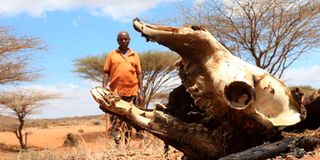Drought scuttles conservation efforts as wild animals perish

A man inspects the carcass of his camel in Marsabit in November 2021.
What you need to know:
- Dozens of animals in Garissa, Wajir and Tana River and parts of Meru National Park have starved to death in recent weeks.
- At the Lewa Wildlife Conservancy, conservationists have already started a supplementary feeding programme.
The death of wildlife due to the ongoing drought is disrupting conservation efforts. With depressed rainfall in Wajir, Garissa, Isiolo and Marsabit counties, endangered wildlife species are beginning to die, dealing a major blow to years of conservation.
The situation has been exacerbated by competition for already scarce pasture and water among pastoralist communities. Cases of human-wildlife conflict are intensifying.
The situation could get worse, with the Kenya Meteorological Department forecasting depressed rainfall going into the November-December short-rains season. Dozens of giraffes, gerenuk gazelles and buffaloes in Garissa, Wajir and Tana River and parts of Meru National Park have starved to death in recent weeks.
The situation is dire, observed Mr Robert Obrein, the Kenya Wildlife Service (KWS) assistant director in charge of the Eastern region, who has written to the government seeking food supplements for rhinos and hippos.
The problem has been aggravated by an influx of illegal herders, who have driven hundreds of camels and cattle from Garissa and Wajir to the area, heightening competition for scarce pasture. Elephants, which feed day and night, must trek long distances in search of vegetation as most acacia trees have fallen, Mr Obrein said.
He said the situation could worsen if, by December, the area will not have received sufficient rainfall.
“Giraffes are dying daily in Garissa, while we are witnessing deaths of buffaloes in Tana River. We have written to the government hoping that it will come in and help the rhinos and hippos that are really suffering,” he said.
Prevailing dry spell
“It is not fair for us to lose wildlife to drought after we have guarded them for that long. Hippos are emerging from the water but there is nothing to feed on.”
At the Lewa Wildlife Conservancy, conservationists have already started a supplementary feeding programme targeting suckling mothers and old rhinos so as to save them from starving to death.
Lewa rhino monitoring officer Kenneth Onzere said this is meant to ensure that vulnerable rhinos are not lost to the prevailing dry spell, which has reduced pasture.
The sanctuary that hosts the re-listed endangered black rhino had recorded 25 births by the end of September this year.
Rhino health experts project the number to rise to 30 by the end of the year at the conservancy with 239 rhinos, 126 of them black and 113 white.
But this progress may be derailed if the drought continues.
Mr Onzere said the special group of rhinos were being fed with lucerne grass.
They also supply the animals with Euphorbia ingens, a thorny, evergreen, succulent tree with a short trunk that usually grows in dry areas like the Buuri region.




